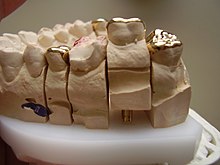Plaster model (dental technology)
In dentistry, on the one hand, plaster models of the teeth are made in order to record the initial situation before a treatment, which are called situation models. On the other hand, dentures , bite splints , orthodontic appliances or mouth guards are made on plaster models . Before making the plaster model, an impression of the teeth or the jaw is taken with the help of a ready-made or individually made impression tray . The precision of the dental workpiece to be manufactured depends on the precision of the impression and the model .
Model types
Situation models are used for diagnostic evaluation (for example in the case of a temporomandibular joint syndrome) and for documentation and analysis of the oral situation. Dental workpieces are manufactured on working models. The final fine-tuning and delivery to the dentist is then carried out on the so-called master model .
Chemical composition
Gypsum is a doubly hydrated calcium sulfate in crystalline form (CaSO 4 .2H 2 O). By removing the water of crystallization, the plaster of paris becomes dental plaster with the chemical formula: CaSO 4 · ½H 2 O (calcium sulfate hemihydrate). In the case of dental plaster, the ADA and DIN EN ISO 6873 standards differentiate between the following types:
- Type I: Casting and impression plaster, β-hemihydrate, 0.15% setting expansion and 4 N / mm² compressive strength
- Type II: Alabaster plaster of paris, β-hemihydrate, 0.3% setting expansion and 9 N / mm² compressive strength
- Type III: hard plaster of paris, α-hemihydrate, 0.2% setting expansion and 20 N / mm² compressive strength
- Type IV: super hard stone, α-hemihydrate, 0.15% setting expansion, 35 N / mm² compressive strength
- Type V: super hard stone, α-hemihydrate, 0.3% setting expansion, 35 N / mm² compressive strength
Hard plaster or super hard plaster are used for situational models. Particularly flowable plasters are "plastic-coated". This involves the greater admixture of flow improvers based on water-soluble synthetic resins. This includes all type IV and V super hard plasters with a mixing ratio of 18-22 ml of water to 100 g of powder. A plastic-modified, thixotropic dental plaster has optimal flow properties and can nevertheless be processed immediately to build up.
Manufacturing
Mixing
The plaster is mixed either by hand in a smooth-walled rubber bowl with a spatula or in a mechanical plaster mixer under vacuum . The dosage for the gypsum powder / water ratio specified by the manufacturer must be observed. The plaster of paris should be free of air bubbles and have a creamy consistency.
Fill up
When filling the impression, the gypsum paste is applied in small portions. Under the vibrations of the shaker , which is supposed to ensure air bubble-free filling, the gypsum paste is allowed to slowly flow into the deepest parts of the dental arch before the entire impression is filled.
Base manufacture
The casting of the impression and the production of the base can be carried out in one or two phases. The impression filled with plaster of paris is pressed into the freshly mixed base plaster mass with slight shaking movements. A base former can be used for this.
Trim
After the plaster has hardened, the model is brought into its final shape on a trimmer (electrically operated grinding wheel with water cooling). If the model is to be permanently mounted in an articulator , the lower surface is roughened beforehand. This creates a better bond with the plaster of paris. If a split mounting of the models is planned (production of so-called split cast models that can be easily removed from the articulation and repositioned), the smooth undersurface of the model must be provided with notches in order to ensure that the model is clearly repositioned in the articulator. Alternatively, so-called pins or magnets can be used for this.
Splitcast model
For the preparation of crowns and bridges a is split cast model produced which can be easily removed from the articulation. In addition, the individual plaster teeth are sawn out of the model in order to be able to precisely model the dental workpieces to be produced on each tooth. This creates a saw cut model. This can be done either with a small hand saw or an electrically driven, thin plaster cutting disc. The individual plaster teeth can, for example , be put back exactly in their original position in the model by means of dowel pins , tapered pins that are attached in pairs .
Individual evidence
- ↑ a b c Training to become a dental technician . Neuer Merkur GmbH, 1996, ISBN 978-3-929360-01-1 , p. 80 ff . ( limited preview in Google Book search).
- ↑ Wolfgang Stelzenmüller: Therapy of temporomandibular joint pain: a treatment concept for dentists, orthodontists and physiotherapists; 94 tables . Georg Thieme, 2010, ISBN 978-3-13-131382-9 , p. 320 ff . ( limited preview in Google Book search).
- ^ Siegfried Ernst, Hans H. Caesar: The non-metals . Neuer Merkur GmbH, 2007, ISBN 978-3-937346-31-1 , p. 58 ( limited preview in Google Book search).
- ↑ Picodent dental plaster
- ↑ Jan Wilczek: Pouring an impression with plaster of paris to create a situation model (instruction for dental technician) . GRIN, 2006, ISBN 978-3-638-55883-9 , pp. 1 ff . ( limited preview in Google Book search).





